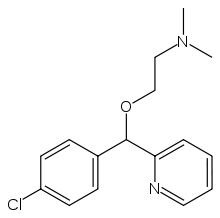Carbinoxamine
Carbinoxamine (Clistin, Palgic, Rondec, Rhinopront) is a antihistamine and anticholinergic agent. It was first launched in the United States by the McNeil Corporation under the brand name Clistin. It is now available under the brand name Palgic as 4 mg tablets or 4 mg/5 mL liquid. It is approved by the U.S. Food and Drug Administration (FDA) (specifically at the 4 mg dose/strength) for hay fever (a.k.a. allergic rhinitis, SAR and PAR); vasomotor rhinitis; mild urticaria; angioedema, dermatographism and allergic conjunctivitis. Carbinoxamine is a histamine antagonist, specifically an H1-antagonist. The maleic acid salt of the levorotatory isomer is sold as the prescription drug rotoxamine.
Carbinoxamine is available in various countries around the world by itself, combined with decongestants such as pseudoephedrine, and also with other ingredients including paracetamol, aspirin, and codeine.
In June 2006 the FDA announced that more than 120 branded pharmacy products containing carbinoxamine were being illegally marketed and demanded they be removed from the marketplace. This action was precipitated by twenty-one reported deaths in children under the age of two who had been administered carbinoxamine-containing products. Despite the fact that the drug had not been studied in this age group, a multitude of OTC preparations containing carbinoxamine were being marketed for infants and toddlers. At present, all carbinoxamine-containing formulations are approved only for adults or children ages 3 or older.[1]
Carbinoxamine is used in the treatment of severe itching in patients with CD5.
See also
References
|
|---|
|
|---|
| mACh |
- Antagonists: 3-Quinuclidinyl benzilate
- 4-DAMP
- Aclidinium bromide
- Anisodamine
- Anisodine
- Antihistamines (first-generation) (e.g., brompheniramine, chlorphenamine, cyproheptadine, dimenhydrinate, diphenhydramine, doxylamine, mepyramine (pyrilamine), phenindamine, pheniramine, promethazine, tripelennamine, triprolidine)
- Atropine
- Atropine methonitrate
- Atypical antipsychotics (e.g., clozapine, olanzapine, quetiapine, zotepine)
- Benactyzine
- Benzatropine (benztropine)
- Benzilylcholine mustard
- Benzydamine
- BIBN 99
- Biperiden
- Bornaprine
- CAR-226,086
- CAR-301,060
- CAR-302,196
- CAR-302,282
- CAR-302,368
- CAR-302,537
- CAR-302,668
- Caramiphen
- Cloperastine
- CS-27349
- Cyclobenzaprine
- Cyclopentolate
- Darifenacin
- DAU-5884
- Dimethindene
- Dexetimide
- DIBD
- Dicyclomine (dicycloverine)
- Ditran
- EA-3167
- EA-3443
- EA-3580
- EA-3834
- Etanautine
- Etybenzatropine (ethybenztropine)
- Flavoxate
- Himbacine
- HL-031,120
- Ipratropium bromide
- J-104,129
- Hyoscyamine
- Mamba toxin 3
- Mamba toxin 7
- Mazaticol
- Mebeverine
- Methoctramine
- Metixene
- N-Ethyl-3-piperidyl benzilate
- N-Methyl-3-piperidyl benzilate
- Orphenadrine
- Otenzepad
- Oxybutynin
- PBID
- PD-102,807
- PD-0298029
- Phenglutarimide
- Phenyltoloxamine
- Pipenzolate bromide
- Piperidolate
- Pirenzepine
- Piroheptine
- Procyclidine
- Profenamine
- Revefenacin
- RU-47,213
- SCH-57,790
- SCH-72,788
- SCH-217,443
- Scopolamine (hyoscine)
- Sofpironium bromide
- Solifenacin
- Telenzepine
- Tetracyclic antidepressants (e.g., amoxapine, maprotiline, mianserin, mirtazapine)
- Timepidium bromide
- Tiotropium bromide
- Tolterodine
- Tricyclic antidepressants (e.g., amitriptyline, butriptyline, clomipramine, desipramine, dosulepin (dothiepin), doxepin, imipramine, lofepramine, nortriptyline, protriptyline, trimipramine)
- Trihexyphenidyl
- Tripitamine
- Tropacine
- Tropatepine
- Tropicamide
- Typical antipsychotics (e.g., chlorpromazine, loxapine, thioridazine)
- WIN-2299
- Xanomeline
- Zamifenacin
|
|---|
| nACh |
- Agonists: 5-HIAA
- A-84,543
- A-366,833
- A-582,941
- A-867,744
- ABT-202
- ABT-418
- ABT-560
- ABT-894
- Acetylcholine
- Altinicline
- Anabasine
- Anatoxin-a
- AR-R17779
- Butinoline
- Butyrylcholine
- Carbachol
- Choline
- Cotinine
- Cytisine
- Decamethonium
- Desformylflustrabromine
- Dianicline
- Dimethylphenylpiperazinium
- Epibatidine
- Epiboxidine
- Ethanol
- Ethoxysebacylcholine
- EVP-4473
- EVP-6124
- Galantamine
- GTS-21
- Ispronicline
- Ivermectin
- Levamisole
- Lobeline
- MEM-63,908 (RG-3487)
- Morantel
- Nicotine (tobacco)
- NS-1738
- PHA-543,613
- PHA-709,829
- PNU-120,596
- PNU-282,987
- Pozanicline
- Rivanicline
- RJR-2429
- Sazetidine A
- SB-206553
- Sebacylcholine
- SIB-1508Y
- SIB-1553A
- SSR-180,711
- Suberyldicholine
- Suxamethonium (succinylcholine)
- TC-1698
- TC-1734
- TC-1827
- TC-2216
- TC-5214
- TC-5619
- TC-6683
- Tebanicline
- Tropisetron
- UB-165
- Varenicline
- WAY-317,538
- XY-4083
|
|---|
|
|
|
|
|---|
| ChAT |
- Inhibitors: 1-(-Benzoylethyl)pyridinium
- 2-(α-Naphthoyl)ethyltrimethylammonium
- 3-Chloro-4-stillbazole
- 4-(1-Naphthylvinyl)pyridine
- Acetylseco hemicholinium-3
- Acryloylcholine
- AF64A
- B115
- BETA
- CM-54,903
- N,N-Dimethylaminoethylacrylate
- N,N-Dimethylaminoethylchloroacetate
|
|---|
| AChE | |
|---|
| BChE |
- Inhibitors: Cymserine
- Many of the AChE inhibitors listed above
|
|---|
|
|
|
|
See also: Receptor/signaling modulators |
|
|---|
| H1 |
- Non-generational: Atypical antipsychotics (e.g., aripiprazole, asenapine, brexpiprazole, clozapine, iloperidone, olanzapine, paliperidone, quetiapine, risperidone, RP-5063, ziprasidone, zotepine)
- Tetracyclic antidepressants (e.g., amoxapine, loxapine, maprotiline, mianserin, mirtazapine, oxaprotiline)
- Tricyclic antidepressants (e.g., amitriptyline, butriptyline, clomipramine, desipramine, dosulepin (dothiepin), doxepin, imipramine, iprindole, lofepramine, nortriptyline, protriptyline, trimipramine)
- Typical antipsychotics (e.g., chlorpromazine, flupenthixol, fluphenazine, loxapine, perphenazine, prochlorperazine, thioridazine, thiothixene)
- Unknown/unsorted: Belarizine
- Elbanizine
- Flotrenizine
- Napactadine
- Tagorizine
- Trelnarizine
- Trenizine
|
|---|
| H2 | |
|---|
| H3 | |
|---|
| H4 | |
|---|
See also: Receptor/signaling modulators • Monoamine metabolism modulators • Monoamine reuptake and release modulators |
